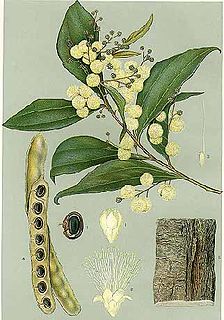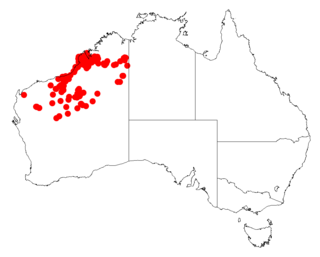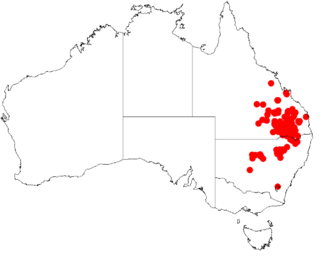
Acacia translucens, commonly known as poverty bush, is a shrub that is endemic to a large area of north western Australia.

Acacia inaequilatera, commonly known as kanji bush, baderi, camel bush, fire wattle, kanyji bush or ranji bush is a tree in the family Mimosaceae. Endemic to Australia, it is widely distributed in the semi-arid Triodia country eastwards from Karratha, Western Australia into the Northern Territory.

Acacia murrayana is a tree in the family Fabaceae. It has numerous common names, including sandplain wattle, Murray's wattle, fire wattle, colony wattle and powder bark wattle that is endemic to arid areas in every mainland State except Victoria.

Acacia colei is a perennial bush or tree native to northern Australia and southern Asia. A common name for it is Cole's wattle. Acacia colei blooms from May through September and the flowers are bright yellow.

Acacia binervata, commonly known as two-veined hickory, is a shrub or tree that is endemic to eastern Australia.

Acacia bivenosa, commonly known as two-nerved wattle, two-veined wattle or hill umbrella bush, is a species of Acacia found in northern Australia.

Acacia eriopoda, commonly known as the Broome pindan wattle and the narrow-leaf pindan wattle, is a species of wattle in the legume family that is native to northern Western Australia. It is also known as Yirrakulu to the Nyangumarta people.
Acacia anastomosa, also known as Carson River wattle, is a shrub belonging to the genus Acacia and the subgenus Juliflorae that is endemic to north western Australia.

Acacia oncinocarpa is a shrub or tree belonging to the genus Acacia and the subgenus Juliflorae that is endemic to northern Australia.

Acacia pellita is a shrub or tree belonging to the genus Acacia and the subgenus Juliflorae that is endemic to parts of tropical northern Australia.

Acacia ptychophylla is a shrub belonging to the genus Acacia and the subgenus Juliflorae the is endemic to arid areas of north western Australia.

Acacia rhodophloia, commonly known as minni ritchi or western red mulga, is a tree or shrub belonging to the genus Acacia and the subgenus Juliflorae that is endemic to a large area of arid central western Australia. The Indigenous group the Kurrama peoples know the plant as mantaru.
Acacia seclusa, commonly known as saw range wattle, is a small tree belonging to the genus Acacia and the subgenus Juliflorae that is endemic to northern Australia.

Acacia stipuligera is a tree or shrub belonging to the genus Acacia and the subgenus Juliflorae. It is native to arid and tropical parts of northern Australia.

Acacia wickhamii is a shrub belonging to the genus Acacia and the subgenus Juliflorae that is endemic to parts of northern Australia.

Acacia strongylophylla, commonly known as round-leaf wattle, is a shrub of the genus Acacia and the subgenus Phyllodineae endemic to central Australia.

Acacia linearifolia, commonly known as stringybark wattle or narrow-leaved wattle, is a shrub or tree of the genus Acacia and the subgenus Phyllodineae that is endemic to eastern Australia.

Acacia burrowii, commonly known as Burrow's wattle, is a tree belonging to the genus Acacia and the subgenus Juliflorae that is native to eastern Australia.
Acacia gracillima is a shrub or tree belonging to the genus Acacia and the subgenus Juliflorae that is native to north western Australia.

Acacia striatifolia is a shrub or tree belonging to the genus Acacia and the subgenus Juliflorae that is native to north eastern Australia.

















